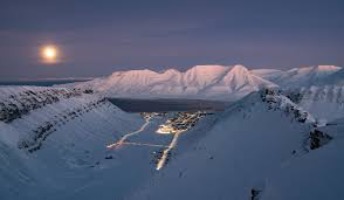
Climate change is taking a firm grip on the planet and is likely to affect every country, but some more significantly than others. Nations with ineffective governments, or those places with widespread poverty are likely to suffer, due to being poorly equipped to deal with their own particular environmental risks.
From West Africa to the islands of the Pacific, and from the Caribbean to the Middle East, there are areas where the impact is being severely felt; but nowhere on earth is suffering more rapidly than a tiny archipelago deep inside the Arctic Circle, where it is estimated to be heating up at an astonishing SIX times the global average.
Scientists identify alarming temperature rises
Svalbard, sometimes referred to as Spitsbergen, is the Norwegian island chain in the Arctic Ocean, located more or less half way between the north coast of Norway and the North Pole. It is pretty much on top of the world and contains uninterrupted areas of untouched wilderness. It is also home to Longyearbyen, the world’s northernmost permanent settlement with less than 2,500 residents, and is a popular tourist destination, as well as being an important centre for Arctic research.
It is scientists conducting this research at the site who have spotted that temperatures are causing unprecedented thawing of frozen lands as they continue to rise alarmingly, with their measurements confirming a 4 degrees Celsius increase over the past 50 years.
Indeed, since the 1980’s, the amount of summer sea ice has halved, with those living there literally seeing the ground shifting beneath their feet, prompting some of the scientists to express genuine concern that it will be gone altogether by 2035.
From whalers and miners to researchers and tourists
The archipelago, of which something in the region of 60 per cent is covered with glaciers, surrounding its many mountains and fjords, is a breeding ground for all manner of seabirds and certain marine mammals.
It was initially used as a base by whalers back in the 17th century, but it was coal mining that changed things in the 20th century, and that is when several permanent communities were established – including Longyearbyen (the capital) – although now only one mine remains, due to the precarious state it finds itself in.
The place has Norwegian sovereignty, and is accepted as a free economic and demilitarized zone. Research and tourism have become very important supplementary industries today.
Six times the global average for warming
Experts from the Norwegian Polar Institute are among those who have made the calculation that the place is heating SIX times faster than what has become established as the global average. In July 2020, Longyearbyen recorded a temperature of 21.7 degrees, breaking a 41-year record. The upshot is that both human life and wildlife now face a real struggle to survive in the area, with time beginning to run out.
Nowhere to go
Kim Holmén, a professor of climate and the environment, as well as a special advisor at the Norwegian Polar Institute, has been studying Svalbard for more than 40 years. He pointed out that habitats for wildlife are being severely affected; saying: “Most endemic species cannot adapt quickly enough, and migration to colder regions is simply impossible. We are at the very end, there is no land north of us for them to move to.”
Polar Bear watch
There are threats all around, from a host of different dangers. The risk of avalanches is ever-present throughout the winter months, which turns to fear of mudslides in the summer, which can be equally, or quite often even more devastating, to communities.
An additional problem now comes in the frightening form of polar bears, who with the ice melting are finding it harder to hunt, which is driving them into built up areas in search of food. The unfortunate reindeer are first on the menu, but people are fearful for their own safety as the animals become more desperate.
Major concern over avalanches and mudslides
The temperature rises have meant heavier rain and wet snow, and after a deluge in 2015, the main settlement and capital experienced its most devastating avalanche. Eleven houses were displaced from their foundations and tragically two people lost their lives.
Svalbard’s church is the most northerly place of worship in the world. Its priest, Siv Limstrand, is shocked by the impact of climate change. The cemetery has got to be relocated as the risk of landslides and avalanches puts it in real danger of being washed away. She commented that sadly: “This is no longer a safe place for the living, or indeed the dead.”
Threat to permafrost constructions
Across the entire region buildings are constructed on permafrost, ground which has had a temperature of zero degrees, or below, for at least two consecutive years. Historically the archipelago’s structures were fixed on top of wooden piles, which were anchored into the permafrost.
However, increasing ground temperatures have increased the risk of the wood rotting and becoming unstable, as permafrost’s active layer thickens and allows more water to flow in and around buildings.
Huge researcher presence
Thorbjørn Gilberg, a senior advisor at the Svalbard Science Forum (SSF), who has the unenviable task of co-ordinating and advising on all research activities in Svalbard, gave an indication of the massive scale of research now taking place when he revealed that there were 1,000 researchers at the main site, coming from around 200 different institutions, and 35 countries worldwide.
Ironically, it is possible that the funds needed to combat the results of climate change may actually lead to cuts in the funding of more vital research.
War in Ukraine even affecting Svalbard
Even though the place is completely isolated, the events occurring elsewhere in the world are having a damaging effect on the fight to halt, or at least slow the climate change in Svalbard.
The war in Ukraine has seen cooperation between scientists from Russia and the West grind to a stand still, meaning that vital exchanges with Russian institutions are no longer possible, and as more or less half of the Arctic is Russian coastline, the missing data severely clouds the results collected in Svalbard.












0 Comments